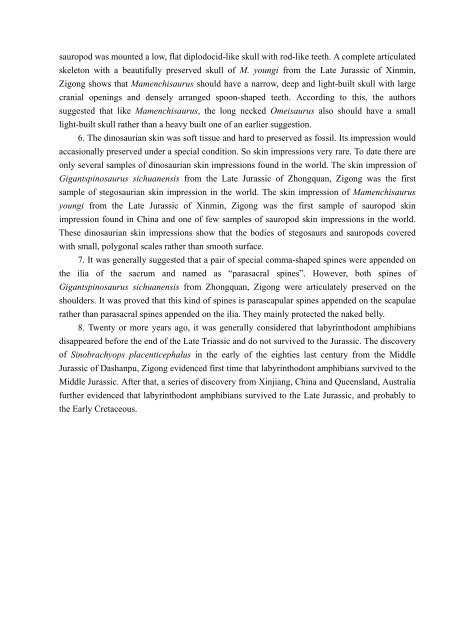JURASSIC DINOSAUR FAUNAS IN ZIGONG - 自贡恐龙博物馆
JURASSIC DINOSAUR FAUNAS IN ZIGONG - 自贡恐龙博物馆
JURASSIC DINOSAUR FAUNAS IN ZIGONG - 自贡恐龙博物馆
You also want an ePaper? Increase the reach of your titles
YUMPU automatically turns print PDFs into web optimized ePapers that Google loves.
sauropod was mounted a low, flat diplodocid-like skull with rod-like teeth. A complete articulated<br />
skeleton with a beautifully preserved skull of M. youngi from the Late Jurassic of Xinmin,<br />
Zigong shows that Mamenchisaurus should have a narrow, deep and light-built skull with large<br />
cranial openings and densely arranged spoon-shaped teeth. According to this, the authors<br />
suggested that like Mamenchisaurus, the long necked Omeisaurus also should have a small<br />
light-built skull rather than a heavy built one of an earlier suggestion.<br />
6. The dinosaurian skin was soft tissue and hard to preserved as fossil. Its impression would<br />
accasionally preserved under a special condition. So skin impressions very rare. To date there are<br />
only several samples of dinosaurian skin impressions found in the world. The skin impression of<br />
Gigantspinosaurus sichuanensis from the Late Jurassic of Zhongquan, Zigong was the first<br />
sample of stegosaurian skin impression in the world. The skin impression of Mamenchisaurus<br />
youngi from the Late Jurassic of Xinmin, Zigong was the first sample of sauropod skin<br />
impression found in China and one of few samples of sauropod skin impressions in the world.<br />
These dinosaurian skin impressions show that the bodies of stegosaurs and sauropods covered<br />
with small, polygonal scales rather than smooth surface.<br />
7. It was generally suggested that a pair of special comma-shaped spines were appended on<br />
the ilia of the sacrum and named as “parasacral spines”. However, both spines of<br />
Gigantspinosaurus sichuanensis from Zhongquan, Zigong were articulately preserved on the<br />
shoulders. It was proved that this kind of spines is parascapular spines appended on the scapulae<br />
rather than parasacral spines appended on the ilia. They mainly protected the naked belly.<br />
8. Twenty or more years ago, it was generally considered that labyrinthodont amphibians<br />
disappeared before the end of the Late Triassic and do not survived to the Jurassic. The discovery<br />
of Sinobrachyops placenticephalus in the early of the eighties last century from the Middle<br />
Jurassic of Dashanpu, Zigong evidenced first time that labyrinthodont amphibians survived to the<br />
Middle Jurassic. After that, a series of discovery from Xinjiang, China and Queensland, Australia<br />
further evidenced that labyrinthodont amphibians survived to the Late Jurassic, and probably to<br />
the Early Cretaceous.


